CER114 Biology: Genetic Inheritance Assignment Solution
VerifiedAdded on 2022/11/28
|11
|1357
|376
Homework Assignment
AI Summary
This document presents a comprehensive solution to a genetic inheritance assignment, covering various aspects of Mendelian genetics. The assignment begins with an analysis of a height distribution graph, demonstrating a normal distribution. It then delves into monohybrid crosses, using Punnett squares to predict offspring genotypes and phenotypes for curly vs. straight hair and brown vs. blue eye color traits. The solution further explores co-dominance by examining blood group inheritance. Dihybrid crosses are addressed with a focus on coat and ear traits in mice. Finally, the assignment concludes with a discussion of Klinefelter's syndrome, including its genetic basis, symptoms, and treatment options, providing a detailed overview of the condition and its impact on individuals.
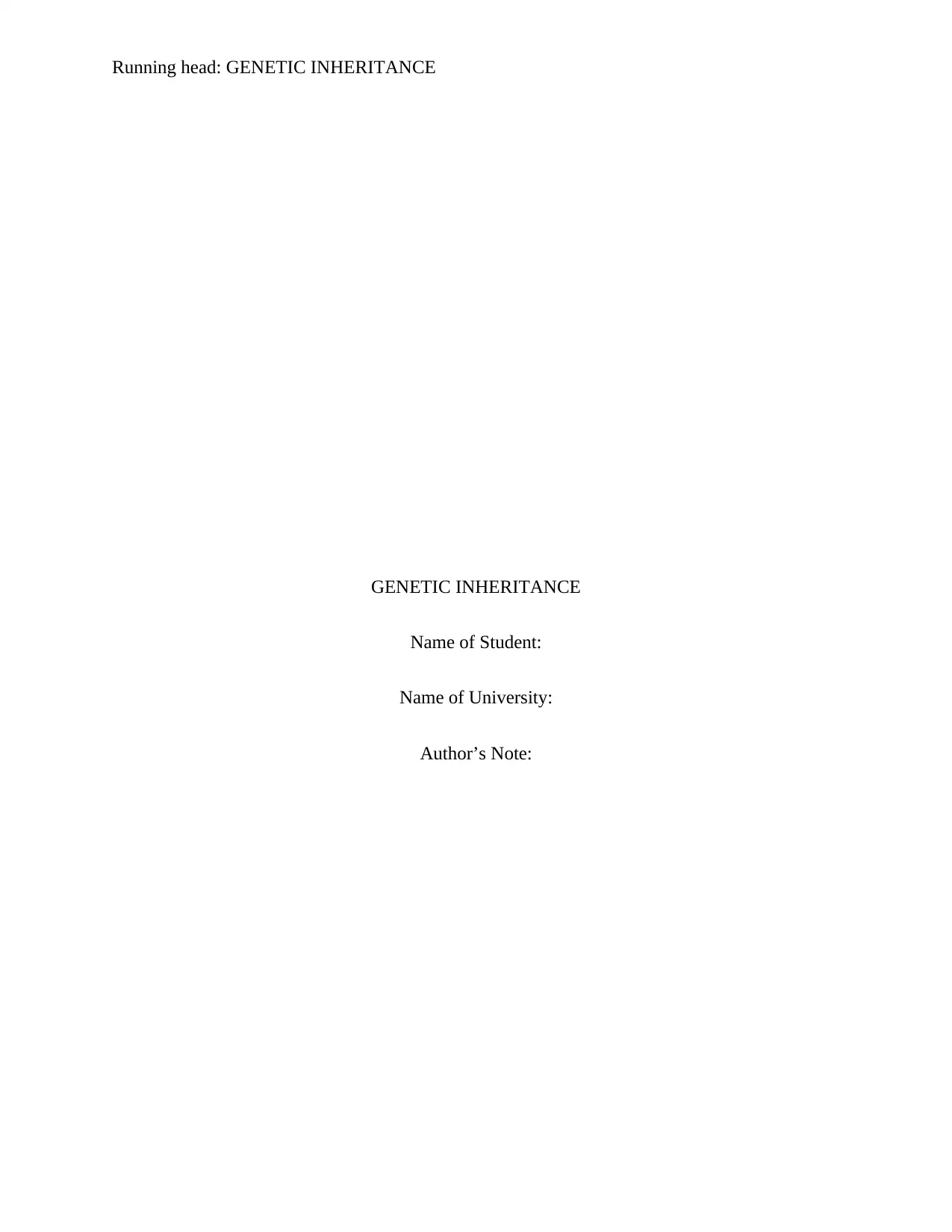
Running head: GENETIC INHERITANCE
GENETIC INHERITANCE
Name of Student:
Name of University:
Author’s Note:
GENETIC INHERITANCE
Name of Student:
Name of University:
Author’s Note:
Paraphrase This Document
Need a fresh take? Get an instant paraphrase of this document with our AI Paraphraser
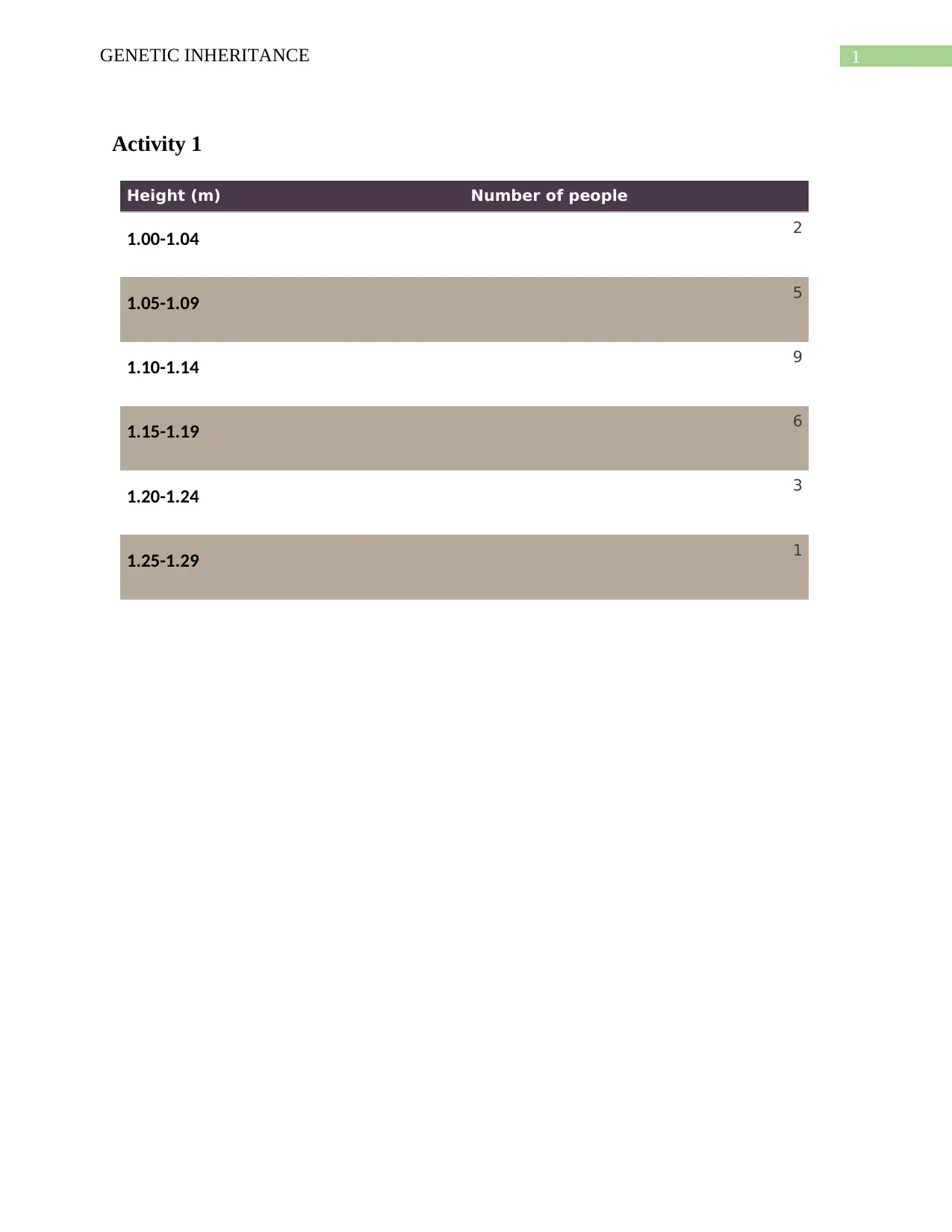
1GENETIC INHERITANCE
Activity 1
Height (m) Number of people
1.00-1.04 2
1.05-1.09 5
1.10-1.14 9
1.15-1.19 6
1.20-1.24 3
1.25-1.29 1
Activity 1
Height (m) Number of people
1.00-1.04 2
1.05-1.09 5
1.10-1.14 9
1.15-1.19 6
1.20-1.24 3
1.25-1.29 1
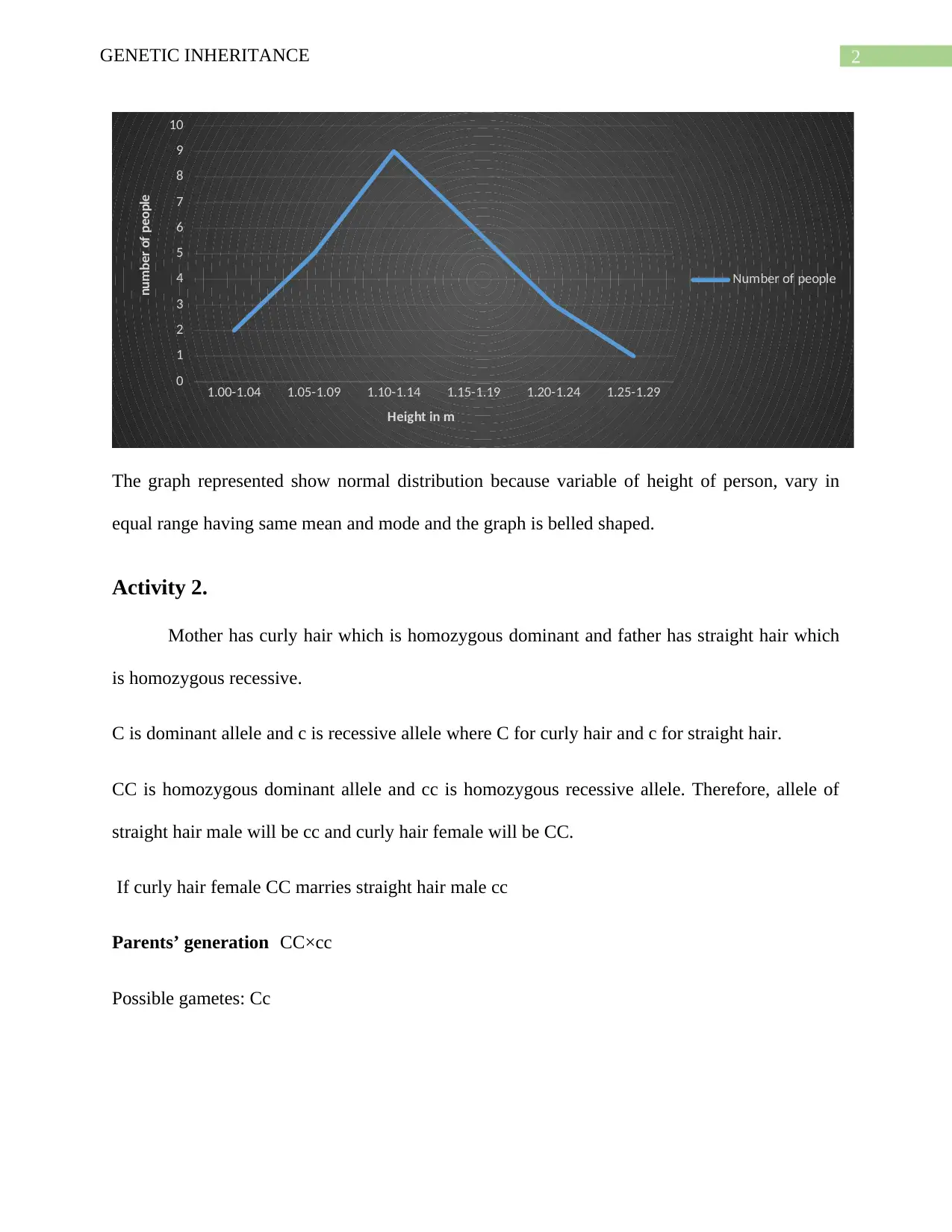
2GENETIC INHERITANCE
1.00-1.04 1.05-1.09 1.10-1.14 1.15-1.19 1.20-1.24 1.25-1.29
0
1
2
3
4
5
6
7
8
9
10
Number of people
Height in m
number of people
The graph represented show normal distribution because variable of height of person, vary in
equal range having same mean and mode and the graph is belled shaped.
Activity 2.
Mother has curly hair which is homozygous dominant and father has straight hair which
is homozygous recessive.
C is dominant allele and c is recessive allele where C for curly hair and c for straight hair.
CC is homozygous dominant allele and cc is homozygous recessive allele. Therefore, allele of
straight hair male will be cc and curly hair female will be CC.
If curly hair female CC marries straight hair male cc
Parents’ generation CC×cc
Possible gametes: Cc
1.00-1.04 1.05-1.09 1.10-1.14 1.15-1.19 1.20-1.24 1.25-1.29
0
1
2
3
4
5
6
7
8
9
10
Number of people
Height in m
number of people
The graph represented show normal distribution because variable of height of person, vary in
equal range having same mean and mode and the graph is belled shaped.
Activity 2.
Mother has curly hair which is homozygous dominant and father has straight hair which
is homozygous recessive.
C is dominant allele and c is recessive allele where C for curly hair and c for straight hair.
CC is homozygous dominant allele and cc is homozygous recessive allele. Therefore, allele of
straight hair male will be cc and curly hair female will be CC.
If curly hair female CC marries straight hair male cc
Parents’ generation CC×cc
Possible gametes: Cc
⊘ This is a preview!⊘
Do you want full access?
Subscribe today to unlock all pages.

Trusted by 1+ million students worldwide
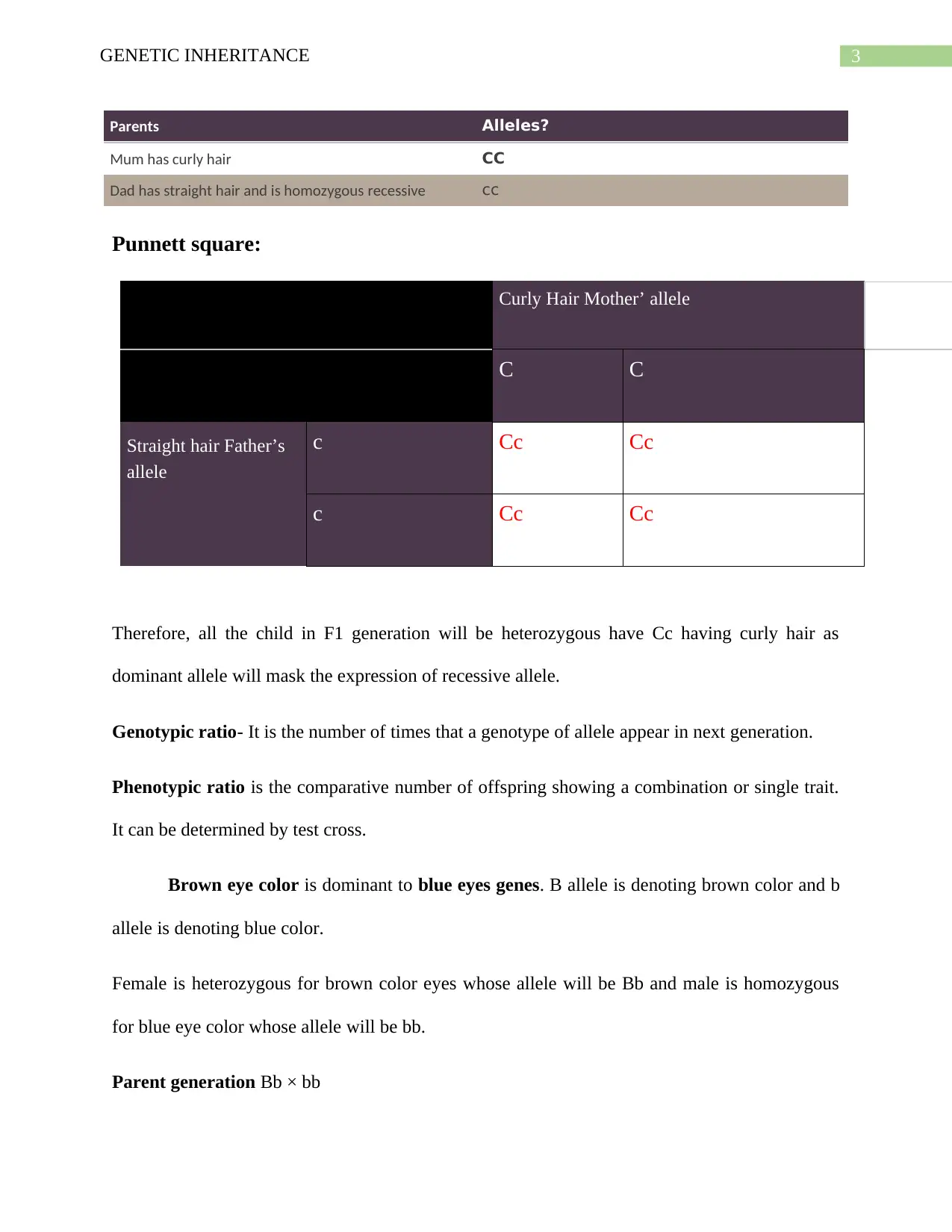
3GENETIC INHERITANCE
Punnett square:
Curly Hair Mother’ allele
C C
Straight hair Father’s
allele
c Cc Cc
c Cc Cc
Therefore, all the child in F1 generation will be heterozygous have Cc having curly hair as
dominant allele will mask the expression of recessive allele.
Genotypic ratio- It is the number of times that a genotype of allele appear in next generation.
Phenotypic ratio is the comparative number of offspring showing a combination or single trait.
It can be determined by test cross.
Brown eye color is dominant to blue eyes genes. B allele is denoting brown color and b
allele is denoting blue color.
Female is heterozygous for brown color eyes whose allele will be Bb and male is homozygous
for blue eye color whose allele will be bb.
Parent generation Bb × bb
Parents Alleles?
Mum has curly hair CC
Dad has straight hair and is homozygous recessive cc
Punnett square:
Curly Hair Mother’ allele
C C
Straight hair Father’s
allele
c Cc Cc
c Cc Cc
Therefore, all the child in F1 generation will be heterozygous have Cc having curly hair as
dominant allele will mask the expression of recessive allele.
Genotypic ratio- It is the number of times that a genotype of allele appear in next generation.
Phenotypic ratio is the comparative number of offspring showing a combination or single trait.
It can be determined by test cross.
Brown eye color is dominant to blue eyes genes. B allele is denoting brown color and b
allele is denoting blue color.
Female is heterozygous for brown color eyes whose allele will be Bb and male is homozygous
for blue eye color whose allele will be bb.
Parent generation Bb × bb
Parents Alleles?
Mum has curly hair CC
Dad has straight hair and is homozygous recessive cc
Paraphrase This Document
Need a fresh take? Get an instant paraphrase of this document with our AI Paraphraser
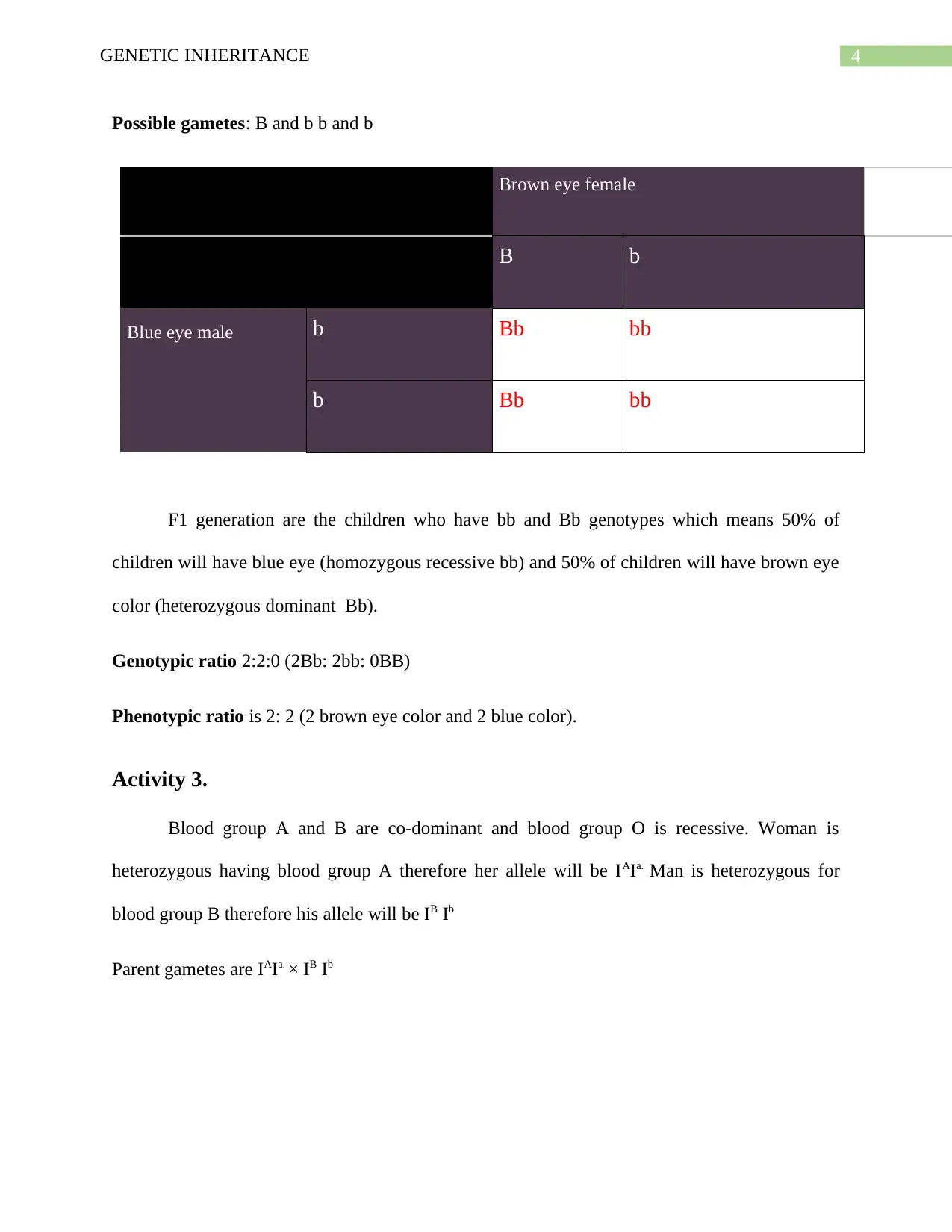
4GENETIC INHERITANCE
Possible gametes: B and b b and b
Brown eye female
B b
Blue eye male b Bb bb
b Bb bb
F1 generation are the children who have bb and Bb genotypes which means 50% of
children will have blue eye (homozygous recessive bb) and 50% of children will have brown eye
color (heterozygous dominant Bb).
Genotypic ratio 2:2:0 (2Bb: 2bb: 0BB)
Phenotypic ratio is 2: 2 (2 brown eye color and 2 blue color).
Activity 3.
Blood group A and B are co-dominant and blood group O is recessive. Woman is
heterozygous having blood group A therefore her allele will be IAIa. Man is heterozygous for
blood group B therefore his allele will be IB Ib
Parent gametes are IAIa. × IB Ib
Possible gametes: B and b b and b
Brown eye female
B b
Blue eye male b Bb bb
b Bb bb
F1 generation are the children who have bb and Bb genotypes which means 50% of
children will have blue eye (homozygous recessive bb) and 50% of children will have brown eye
color (heterozygous dominant Bb).
Genotypic ratio 2:2:0 (2Bb: 2bb: 0BB)
Phenotypic ratio is 2: 2 (2 brown eye color and 2 blue color).
Activity 3.
Blood group A and B are co-dominant and blood group O is recessive. Woman is
heterozygous having blood group A therefore her allele will be IAIa. Man is heterozygous for
blood group B therefore his allele will be IB Ib
Parent gametes are IAIa. × IB Ib
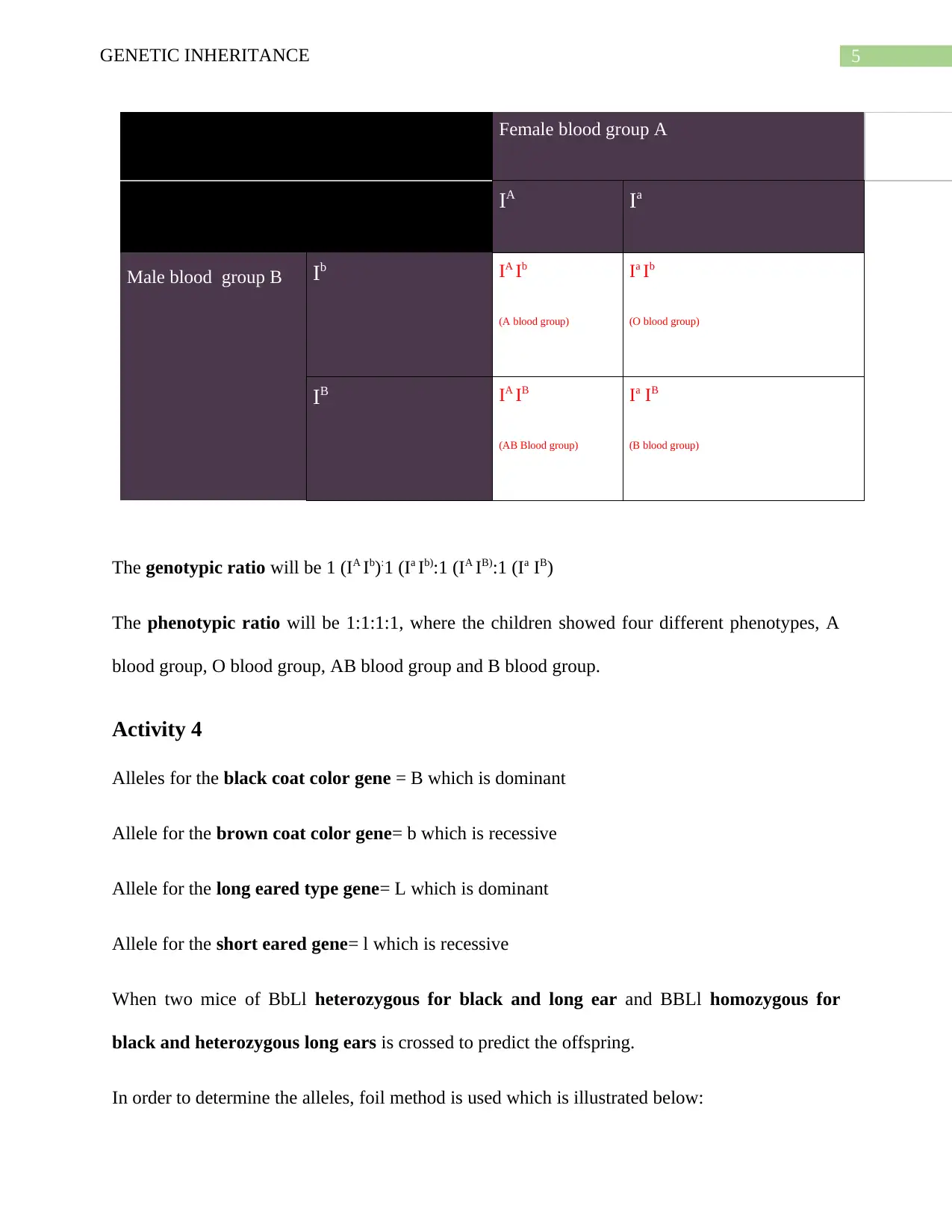
5GENETIC INHERITANCE
Female blood group A
IA Ia
Male blood group B Ib IA Ib
(A blood group)
Ia Ib
(O blood group)
IB IA IB
(AB Blood group)
Ia IB
(B blood group)
The genotypic ratio will be 1 (IA Ib):1 (Ia Ib):1 (IA IB):1 (Ia IB)
The phenotypic ratio will be 1:1:1:1, where the children showed four different phenotypes, A
blood group, O blood group, AB blood group and B blood group.
Activity 4
Alleles for the black coat color gene = B which is dominant
Allele for the brown coat color gene= b which is recessive
Allele for the long eared type gene= L which is dominant
Allele for the short eared gene= l which is recessive
When two mice of BbLl heterozygous for black and long ear and BBLl homozygous for
black and heterozygous long ears is crossed to predict the offspring.
In order to determine the alleles, foil method is used which is illustrated below:
Female blood group A
IA Ia
Male blood group B Ib IA Ib
(A blood group)
Ia Ib
(O blood group)
IB IA IB
(AB Blood group)
Ia IB
(B blood group)
The genotypic ratio will be 1 (IA Ib):1 (Ia Ib):1 (IA IB):1 (Ia IB)
The phenotypic ratio will be 1:1:1:1, where the children showed four different phenotypes, A
blood group, O blood group, AB blood group and B blood group.
Activity 4
Alleles for the black coat color gene = B which is dominant
Allele for the brown coat color gene= b which is recessive
Allele for the long eared type gene= L which is dominant
Allele for the short eared gene= l which is recessive
When two mice of BbLl heterozygous for black and long ear and BBLl homozygous for
black and heterozygous long ears is crossed to predict the offspring.
In order to determine the alleles, foil method is used which is illustrated below:
⊘ This is a preview!⊘
Do you want full access?
Subscribe today to unlock all pages.

Trusted by 1+ million students worldwide
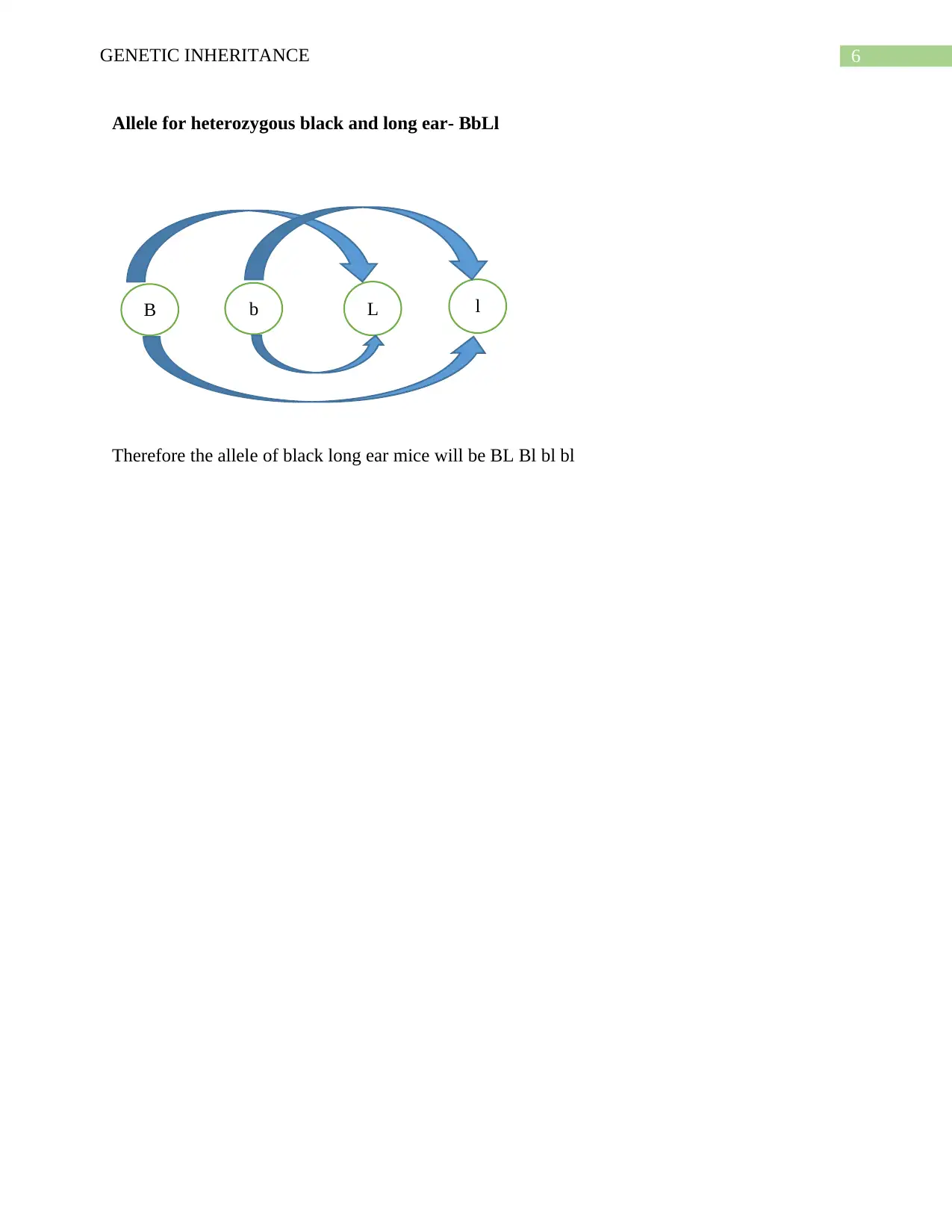
6GENETIC INHERITANCE
Allele for heterozygous black and long ear- BbLl
Therefore the allele of black long ear mice will be BL Bl bl bl
B b L l
Allele for heterozygous black and long ear- BbLl
Therefore the allele of black long ear mice will be BL Bl bl bl
B b L l
Paraphrase This Document
Need a fresh take? Get an instant paraphrase of this document with our AI Paraphraser
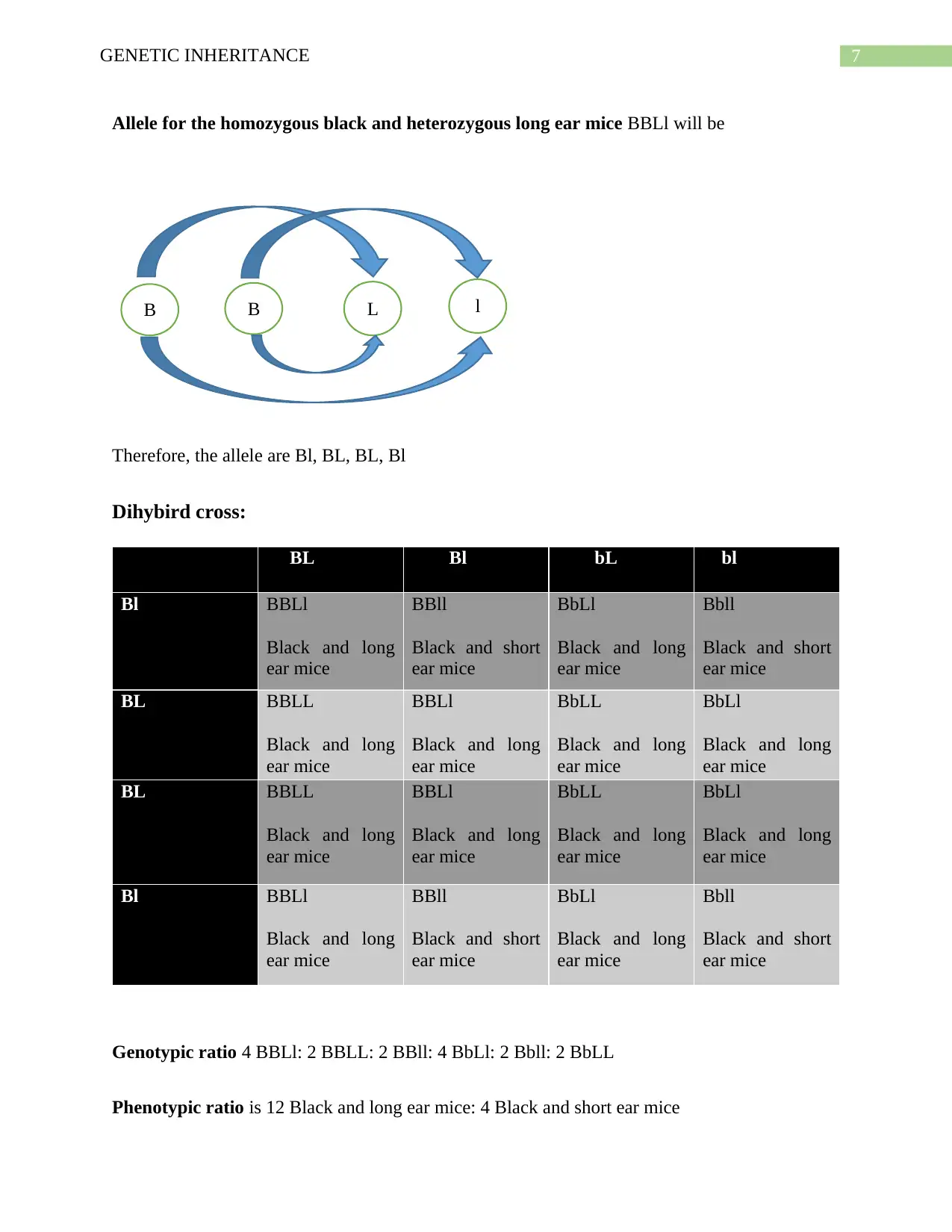
7GENETIC INHERITANCE
Allele for the homozygous black and heterozygous long ear mice BBLl will be
Therefore, the allele are Bl, BL, BL, Bl
Dihybird cross:
BL Bl bL bl
Bl BBLl
Black and long
ear mice
BBll
Black and short
ear mice
BbLl
Black and long
ear mice
Bbll
Black and short
ear mice
BL BBLL
Black and long
ear mice
BBLl
Black and long
ear mice
BbLL
Black and long
ear mice
BbLl
Black and long
ear mice
BL BBLL
Black and long
ear mice
BBLl
Black and long
ear mice
BbLL
Black and long
ear mice
BbLl
Black and long
ear mice
Bl BBLl
Black and long
ear mice
BBll
Black and short
ear mice
BbLl
Black and long
ear mice
Bbll
Black and short
ear mice
Genotypic ratio 4 BBLl: 2 BBLL: 2 BBll: 4 BbLl: 2 Bbll: 2 BbLL
Phenotypic ratio is 12 Black and long ear mice: 4 Black and short ear mice
B B L l
Allele for the homozygous black and heterozygous long ear mice BBLl will be
Therefore, the allele are Bl, BL, BL, Bl
Dihybird cross:
BL Bl bL bl
Bl BBLl
Black and long
ear mice
BBll
Black and short
ear mice
BbLl
Black and long
ear mice
Bbll
Black and short
ear mice
BL BBLL
Black and long
ear mice
BBLl
Black and long
ear mice
BbLL
Black and long
ear mice
BbLl
Black and long
ear mice
BL BBLL
Black and long
ear mice
BBLl
Black and long
ear mice
BbLL
Black and long
ear mice
BbLl
Black and long
ear mice
Bl BBLl
Black and long
ear mice
BBll
Black and short
ear mice
BbLl
Black and long
ear mice
Bbll
Black and short
ear mice
Genotypic ratio 4 BBLl: 2 BBLL: 2 BBll: 4 BbLl: 2 Bbll: 2 BbLL
Phenotypic ratio is 12 Black and long ear mice: 4 Black and short ear mice
B B L l
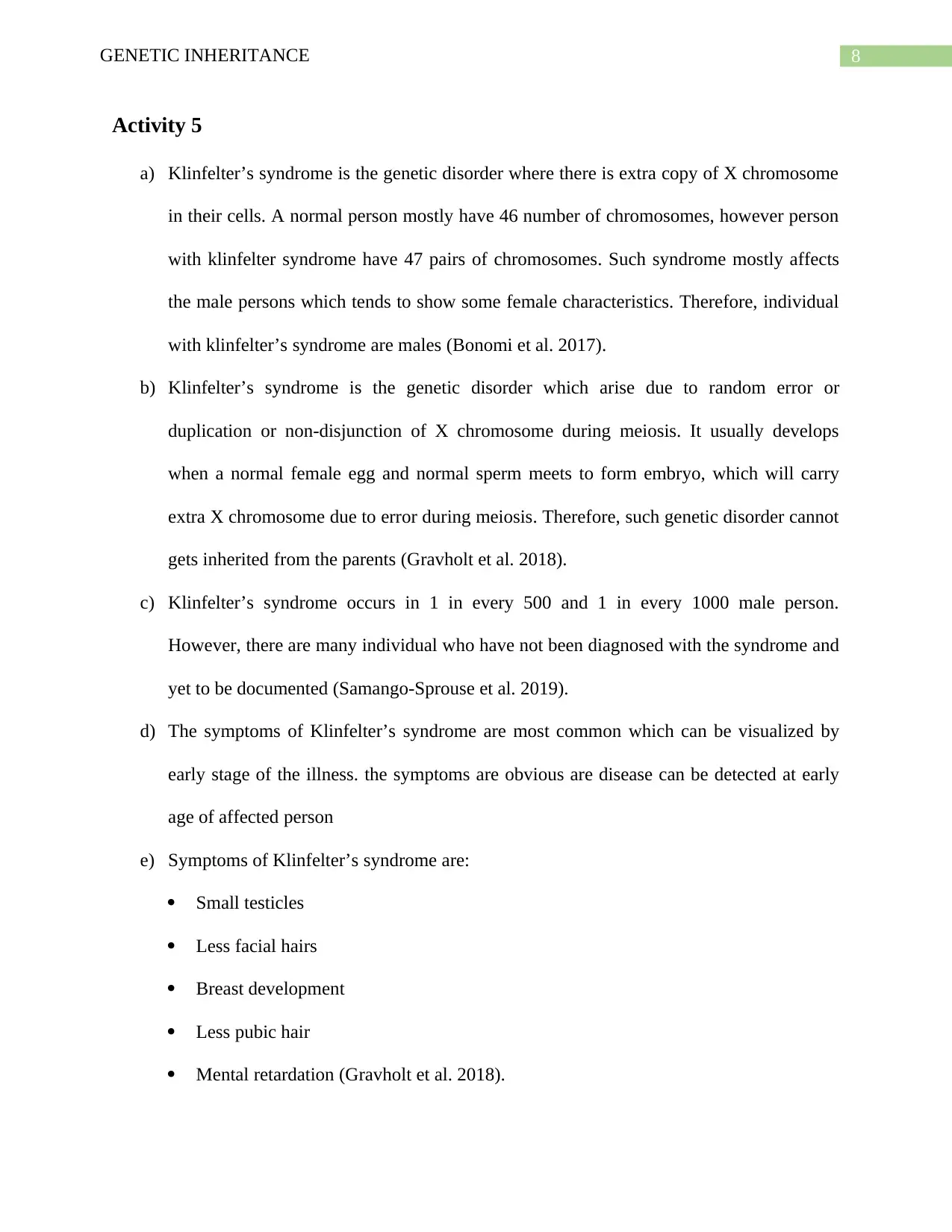
8GENETIC INHERITANCE
Activity 5
a) Klinfelter’s syndrome is the genetic disorder where there is extra copy of X chromosome
in their cells. A normal person mostly have 46 number of chromosomes, however person
with klinfelter syndrome have 47 pairs of chromosomes. Such syndrome mostly affects
the male persons which tends to show some female characteristics. Therefore, individual
with klinfelter’s syndrome are males (Bonomi et al. 2017).
b) Klinfelter’s syndrome is the genetic disorder which arise due to random error or
duplication or non-disjunction of X chromosome during meiosis. It usually develops
when a normal female egg and normal sperm meets to form embryo, which will carry
extra X chromosome due to error during meiosis. Therefore, such genetic disorder cannot
gets inherited from the parents (Gravholt et al. 2018).
c) Klinfelter’s syndrome occurs in 1 in every 500 and 1 in every 1000 male person.
However, there are many individual who have not been diagnosed with the syndrome and
yet to be documented (Samango‐Sprouse et al. 2019).
d) The symptoms of Klinfelter’s syndrome are most common which can be visualized by
early stage of the illness. the symptoms are obvious are disease can be detected at early
age of affected person
e) Symptoms of Klinfelter’s syndrome are:
Small testicles
Less facial hairs
Breast development
Less pubic hair
Mental retardation (Gravholt et al. 2018).
Activity 5
a) Klinfelter’s syndrome is the genetic disorder where there is extra copy of X chromosome
in their cells. A normal person mostly have 46 number of chromosomes, however person
with klinfelter syndrome have 47 pairs of chromosomes. Such syndrome mostly affects
the male persons which tends to show some female characteristics. Therefore, individual
with klinfelter’s syndrome are males (Bonomi et al. 2017).
b) Klinfelter’s syndrome is the genetic disorder which arise due to random error or
duplication or non-disjunction of X chromosome during meiosis. It usually develops
when a normal female egg and normal sperm meets to form embryo, which will carry
extra X chromosome due to error during meiosis. Therefore, such genetic disorder cannot
gets inherited from the parents (Gravholt et al. 2018).
c) Klinfelter’s syndrome occurs in 1 in every 500 and 1 in every 1000 male person.
However, there are many individual who have not been diagnosed with the syndrome and
yet to be documented (Samango‐Sprouse et al. 2019).
d) The symptoms of Klinfelter’s syndrome are most common which can be visualized by
early stage of the illness. the symptoms are obvious are disease can be detected at early
age of affected person
e) Symptoms of Klinfelter’s syndrome are:
Small testicles
Less facial hairs
Breast development
Less pubic hair
Mental retardation (Gravholt et al. 2018).
⊘ This is a preview!⊘
Do you want full access?
Subscribe today to unlock all pages.

Trusted by 1+ million students worldwide
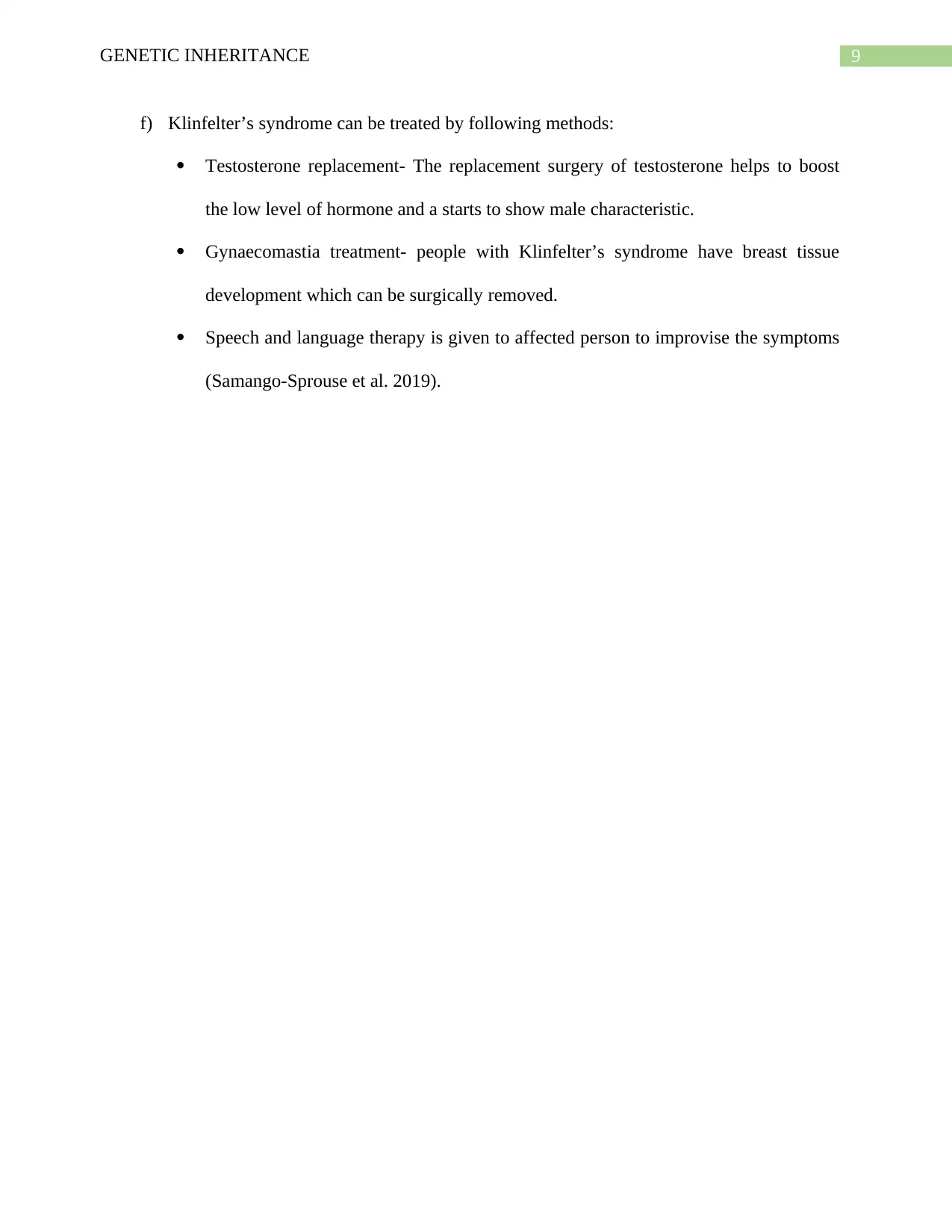
9GENETIC INHERITANCE
f) Klinfelter’s syndrome can be treated by following methods:
Testosterone replacement- The replacement surgery of testosterone helps to boost
the low level of hormone and a starts to show male characteristic.
Gynaecomastia treatment- people with Klinfelter’s syndrome have breast tissue
development which can be surgically removed.
Speech and language therapy is given to affected person to improvise the symptoms
(Samango‐Sprouse et al. 2019).
f) Klinfelter’s syndrome can be treated by following methods:
Testosterone replacement- The replacement surgery of testosterone helps to boost
the low level of hormone and a starts to show male characteristic.
Gynaecomastia treatment- people with Klinfelter’s syndrome have breast tissue
development which can be surgically removed.
Speech and language therapy is given to affected person to improvise the symptoms
(Samango‐Sprouse et al. 2019).
Paraphrase This Document
Need a fresh take? Get an instant paraphrase of this document with our AI Paraphraser
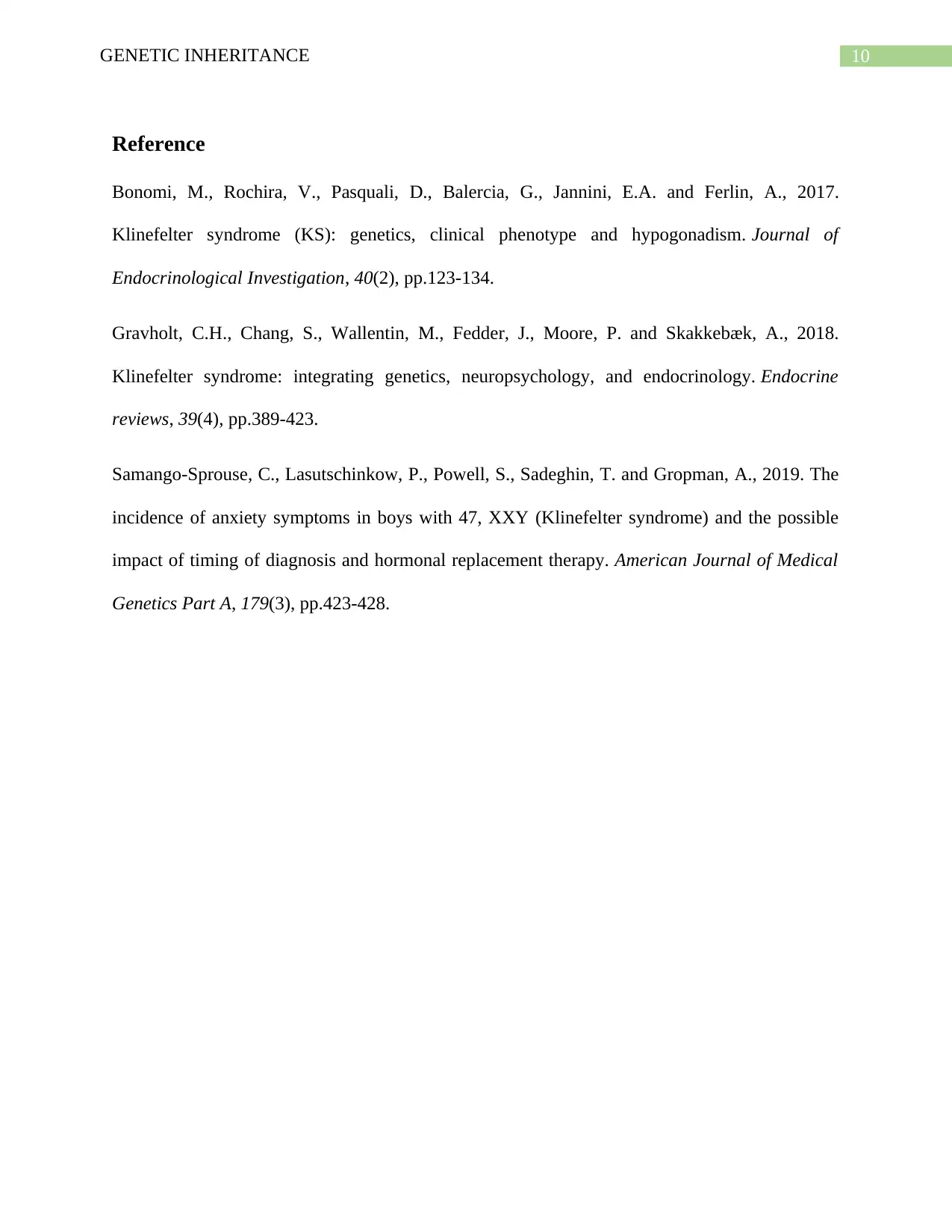
10GENETIC INHERITANCE
Reference
Bonomi, M., Rochira, V., Pasquali, D., Balercia, G., Jannini, E.A. and Ferlin, A., 2017.
Klinefelter syndrome (KS): genetics, clinical phenotype and hypogonadism. Journal of
Endocrinological Investigation, 40(2), pp.123-134.
Gravholt, C.H., Chang, S., Wallentin, M., Fedder, J., Moore, P. and Skakkebæk, A., 2018.
Klinefelter syndrome: integrating genetics, neuropsychology, and endocrinology. Endocrine
reviews, 39(4), pp.389-423.
Samango‐Sprouse, C., Lasutschinkow, P., Powell, S., Sadeghin, T. and Gropman, A., 2019. The
incidence of anxiety symptoms in boys with 47, XXY (Klinefelter syndrome) and the possible
impact of timing of diagnosis and hormonal replacement therapy. American Journal of Medical
Genetics Part A, 179(3), pp.423-428.
Reference
Bonomi, M., Rochira, V., Pasquali, D., Balercia, G., Jannini, E.A. and Ferlin, A., 2017.
Klinefelter syndrome (KS): genetics, clinical phenotype and hypogonadism. Journal of
Endocrinological Investigation, 40(2), pp.123-134.
Gravholt, C.H., Chang, S., Wallentin, M., Fedder, J., Moore, P. and Skakkebæk, A., 2018.
Klinefelter syndrome: integrating genetics, neuropsychology, and endocrinology. Endocrine
reviews, 39(4), pp.389-423.
Samango‐Sprouse, C., Lasutschinkow, P., Powell, S., Sadeghin, T. and Gropman, A., 2019. The
incidence of anxiety symptoms in boys with 47, XXY (Klinefelter syndrome) and the possible
impact of timing of diagnosis and hormonal replacement therapy. American Journal of Medical
Genetics Part A, 179(3), pp.423-428.
1 out of 11
Related Documents
Your All-in-One AI-Powered Toolkit for Academic Success.
+13062052269
info@desklib.com
Available 24*7 on WhatsApp / Email
![[object Object]](/_next/static/media/star-bottom.7253800d.svg)
Unlock your academic potential
Copyright © 2020–2025 A2Z Services. All Rights Reserved. Developed and managed by ZUCOL.





